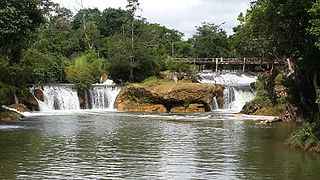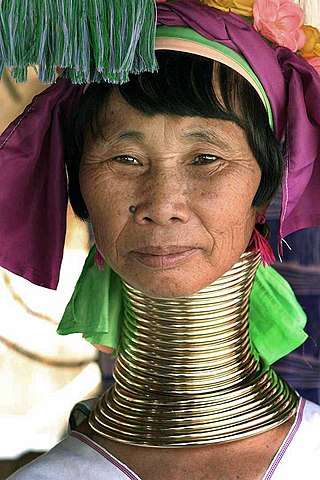
Kayah State, or Karenni State, is a state of Myanmar. Situated in eastern Myanmar, it is bounded on the north by Shan State, on the east by Thailand's Mae Hong Son Province, and on the south and west by Kayin State. It lies approximately between 18° 30′ and 19° 55′ north latitude and between 96° 50′ and 97° 50′ east longitude. The area is 11,670 km2 (4,510 sq mi). Its capital is Loikaw. The estimated population in the 2014 Myanmar Census was 286,738, the smallest among Myanmar's seven states. It is inhabited primarily by the Karenni ethnic group, also known as Red Karen or Kayah, a Sino-Tibetan people.

The Karen, also known as the Kayin, Kariang or Kawthoolese, are an ethnolinguistic group of Tibeto-Burman language-speaking people. The group as a whole is heterogeneous and disparate as many Karen ethnic groups do not associate or identify with each other culturally or linguistically. These Karen groups reside primarily in Kayin State, southern and southeastern Myanmar. The Karen account for around 6.69% of the Burmese population. Many Karen have migrated to Thailand, having settled mostly on the Myanmar–Thailand border. A few Karen have settled in the Andaman and Nicobar Islands, India, and other Southeast Asian and East Asian countries.

The Karenni States, also known as Red Karen States, was the name formerly given to the states inhabited mainly by the Red Karen, in the area of present-day Kayah State, eastern Burma. They were located south of the Federated Shan States and east of British Burma.

The Karenni, also known as the Kayah or Kayah Li, are a Karen people native to the Kayah State of Myanmar (Burma).

The Karen or Karenic languages are tonal languages spoken by some 4.5 million Karen people. They are of unclear affiliation within the Sino-Tibetan languages. The Karen languages are written using the Karen script. The three main branches are Sgaw, Pwo and Pa'O. Karenni and Kayan are a branch of Karen languages. They are unusual among the Sino-Tibetan languages in having a subject–verb–object word order; other than Karen, Bai and the Chinese languages, Sino-Tibetan languages have a subject–object–verb order. This is likely due to influence from neighboring Mon and Tai languages.

The Kayan are a sub-group of Red Karen, Tibeto-Burman ethnic minority of Myanmar (Burma). The Kayan consists of the following groups: Kayan Lahwi, Kayan Ka Khaung (Gekho), Kayan Kadao, Kayan Lahta, Kayan Ka Ngan, Kayan Kakhi and, sometimes, Bwe people (Kayaw). They are distinct from, and not to be confused with, the Kayan people of Borneo.

Insurgencies have been ongoing in Myanmar since 1948, when the country, then known as Burma, gained independence from the United Kingdom. It has largely been an ethnic conflict, with ethnic armed groups fighting Myanmar's armed forces, the Tatmadaw, for self-determination. Despite numerous ceasefires and the creation of autonomous self-administered zones in 2008, armed groups continue to call for independence, increased autonomy, or federalisation. It is the world's longest ongoing civil war, spanning almost eight decades.

The peopling of Thailand refers to the process by which the ethnic groups that comprise the population of present-day Thailand came to inhabit the region.

The S'gaw,, who refer to themselves as Paganyaw, Pga K'nyau, or K'Nyaw, are an ethnic group of Burma and Thailand. They speak the S'gaw Karen language.

S’gaw, S'gaw Karen, or S’gaw K’Nyaw, commonly known as Karen, is a Sino-Tibetan language spoken by the S'gaw Karen people of Myanmar and Thailand. A Karenic branch of the Sino-Tibetan language family, S'gaw Karen is spoken by over 2 million people in Tanintharyi Region, Ayeyarwady Region, Yangon Region, and Bago Region in Myanmar, and about 200,000 in northern and western Thailand along the border near Kayin State. It is written using the S'gaw Karen alphabet, derived from the Burmese script, although a Latin-based script is also in use among the S'gaw Karen in northwestern Thailand.
The Karen Human Rights Group (KHRG) is a grassroots Karen-led human rights organisation, established in Karen State during 1992 and it is now operating across rural southeast Burma/Myanmar. With over twenty years of experience. KHRG is recognised internationally as an authority on major issues such as internal displacement, forced labour, landmines, conflict and land confiscation in southeast Burma/Myanmar. KHRG works directly with "rural villagers who are suffering abuses such as forced labor, systematic destruction of villagers and crops, forced relocations, extortion, looting, arbitrary detention, torture, sexual assault and summary executions." Most of these abuses were committed by soldiers and officials of the State Peace & Development Council (SPDC), Burma's previous ruling military junta. The organisation's goal is to support villagers in rural Burma, by helping them develop strategies to resist abuse and by translating their testimonies for worldwide distribution, accompanied by supporting photos and documentary evidence.
Karenni or Red Karen, known in Burmese as Kayah, is a Karen dialect continuum spoken by over half a million Kayah people in Burma.
Brek, also known as Brek Karen, Bre, and Kayaw, is a Karen language of Burma.
Bwe, also known as Bwe Karen and Bghai (Baghi), is a Karen language of Burma. It shares 82 to 100% lexical similarity with Geba Karen language.
Ceasefires in Myanmar have been heavily utilized by the Burmese government as a policy to contain ethnic rebel groups and create tentative truces. The first ceasefire was arranged by the State Law and Order Restoration Council in 1989, specifically spearheaded by Khin Nyunt, then the Chief of Military Intelligence, with the Kokang-led National Democratic Alliance Army, which had recently split from the Communist Party of Burma due to internal conflicts.

The Karen conflict is an armed conflict in Kayin State, Myanmar. It is part of the wider internal conflict in Myanmar between the military government and various minority groups. Karen nationalists have been fighting for an independent state, known as Kawthoolei, since 1949. The Karen National Union (KNU) and its Karen National Liberation Army (KNLA) are the most prominent Karen rebel groups. Hundreds of thousands of civilians have been displaced by the conflict, many of whom fled to neighbouring Thailand and survive in refugee camps.
Karen Americans are Americans of full or partial Karen ancestry. They are a recent but rapidly growing immigrant population in the United States. Many Karen who emigrate are refugees as a result of violence in their homeland. Many come either from their traditional homeland of Kawthoolei in Myanmar or from refugee camps in Thailand. Minnesota was reported to have had more than 12,000 Karen residents in 2017, making it the state with the largest Karen community. Other states with significant populations are California, Texas, New York, and Indiana.









